
brian conyngham
-
Posts
85 -
Joined
-
Last visited
-
Days Won
4
Content Type
Profiles
Forums
Blogs
Gallery
Events
Store
Posts posted by brian conyngham
-
-
Harry
PM Sent, thanks for the prompt reply...interesting reading.
Have a great day1
Brian
0 -
Guys
Quite right, Tamara Thomas a lady of "mixed race" from Fishoek in the Cape, apparently took strain as a youngster from her peers, as she spoke with a distinguished accent and was well educated.
Air Force Cross awarded for firefighting, she was a helicopter pilot at the time.
Brian
0 -
Guys
Thanks for following this topic.
Many of these guys suffered terribly and others had it fairly easy, largely depended on what camp they were asigned to. Officers and senior NCO's were treated a lot better than privates. Yes, many of these chaps held grudges for years after the war, an old soldier we knew would never buy any Japanese goods, as a friend of his died in a Jap POW camp. He only drove British cars, his last being a Mini Clubman.
Many POW's in Germany had it a lot better, those assigned to work in factories made the most of their time and supplemented their rations by many means even bartering with the German civilians. All these aspects make these groups special to me.
Brian
0 -
90325 WOII George Phillips Taylor MID
4th Light Bde/2nd Anti-Tank Brigade SAA
(POW from the 28th June 1942 to the 6th June 1944).
Taylor, at 6 foot 1 inch tall and 167 lbs had been born at Kings Heath, England on the 13th March 1906 and at the age of 34 attested as a gunner with the 4th Light Brigade SAA at Durban on the 17th June 1940. He was an Anglican and married giving his address as Flat 6 “Dovehill” Currie Rd, Durban and worked as a secretary with Ellis Brown Ltd in his civilian occupation. On his attestation papers he claimed to have served as a volunteer in the Middlesex Regiment between the years 1921 and 1923.
The 4th Light Brigade SAA was reformed as the 2nd Anti-Tank Regiment SAA whilst still in South Africa. On the 15th October 1940 he attended a course at Potchefstroom and on the 1st November 1940 was promoted to T/L/Bdr. On the same day he was promoted once again this time to A/Bdr! After 2 months he was promoted to T/Bdr with pay on the 1st January 1941. He must have shown a lot of potential as his recorded promotions came regularly. On the 1st February 1941 he was confirmed as an A/Sgt. On the 1st April 1941 he was promoted to T/Sgt from A/Sgt whilst he was serving with “A” Battery and just one month later on the 5th May 1941 he was promoted to T/WOII from T/Sgt. In less than a year he had become a warrant officer something that would normally take up to 20 years in a peace-time army.
On the 23rd June1941 he embarked with the rest of his regiment per SS ”Niew Zeeland” at Durban, disembarking at Port Tewfik on the 11th July1941.
They were to fall under the 2nd SA Division during the next year.
The regiment was very active in the battles of Bardia, Sollum and Halfaya towards the end of 1941 and beginning of 1942. During some of these battles the unit fought alongside many famous British Regiments such as the 9th Lancers, 10th Hussars and the Queens Bays.Taylor’s gallantry citation for an Immediate MM found at KEW states the following:
Date: Period Oct 41- Feb 42
Throughout the period Oct 41 – Feb 42 this Troop Commander has shown the utmost keenness, sense of duty and steadfastness under fire. Particularly on 25 Jan 42 N.E. of ANTELAT in covering the withdrawal of 25 pdrs. He maintained his troop in action until the tanks were within 500 yds. And by his skill and coolness withdrew his troop.
At BARDIA, DEC 41 he again set an example and showed the qualities of leadership and devotion to duty.The above citation was signed by Lt Gen Richie GOC Eighth Army. However the recommended award of an MM was downscaled to a MID! The MID was gazetted on the 28th October 1942.
There is also a story relating to the B Troop 5th Battery 2nd Anti-Tank Regiment that was commanded by him. The story is related by a B Troop 2nd Anti-Tank Regiment Sergeant, R.C. Carlyle and published on page 39 in the official History of the Durban Light Infantry Vol 2. It goes as follows:
“ Eventually we reached the top of a deep wadi in which were parked a number of vehicles including a number of trucks. The sides of the cove were pitted with caves but of a human there no sign although the Arab Bedouin insisted that many Germans were there. It was not a pleasant sensation being watched by an unseen “inpi ka skelm” (Zulu: Enemy in hiding), and not knowing what the resistance would be.
Bombardier Godfrey Young was detailed to take his gun into the gully to tempt the Jerry to reveal himself. The other gun under Bombardier Horace Johnson and the rest of us had to wait on top to lend support if necessary. The infantry (RDLI) mean time had taken up their positions and in so doing had concealed themselves as effectively as the foe.
Before nosing down the road Godfrey Young told his crew to don their helmets, setting the example meanwhile. He had realised the gravity of the situation. That was the first time Godfrey had been known to defer to discretion by wearing his tin hat, and I have it on his own authority that it was the only time during the campaign that he used it.
With Mike Wray at the wheel and Gerald Hughes in the gun seat the portee set off down the track. An extra passenger in the person of George Taylor was sitting on the front mudguard. On reaching a suitable spot Mike was told to slew the vehicle across the road so that the 2- pounder could be brought into action. No sooner said than done and in record time Gerald had his gun laid on a cave across the wadi, range 200 yards and sent a shot into it.
The report as it reverberated in that confined space was deafening and would have done credit to a battery of field guns. The effect was instantaneous. From almost every cave the enemy came scrambling with arms aloft in surrender to the infantrymen who straightaway broke cover and with fixed bayonets advanced to consolidate the position. Once it had been established that there would be no opposition the Germans and a few Italians were allowed to collect their personal belongings, which was the work of seconds. The operation produced not only prisoners but large quantities of delicatessen and choice liquors so they lived in the lap of luxury with perishables replenished by submarines at frequent intervals from the jetty in the inlet to supply food and requirements for panzer artisans.”
On the 28th June 1942 after only spending 11 months “up-north” and a week after the fall of Tobruk he was taken prisoner. A capture date a week after the fall of Tobruk points to him possibly escaping from Tobruk, as a number of soldiers did, only to be rounded up days later. He was promoted to a substantive rank of WOII whilst he was a POW on the 1st September 1943. Release dates in his records are contradictory but it appears he was finally released as a POW on the 6th June 1944. POW’s who were interned in Italy being released or returning to Allied lines in mid 1944 are unusual and it is quite possible he might have been “on the run and in hiding” from September 1943 after the capitulation of Italy. Many POW’s escaped or were released in September 1943, a large number were returned to captivity however a number remained “at large” awaiting the advancing Allied forces. He also earned an Italy Star which would point to service with Italian partisan forces; unfortunately there is no written proof of this fact in his available records.He arrived in Egypt on the 13th June 1944, and just ten days later on the 23rd June 1944 emplaned for the Union.
Back in the Union he attended Military College “On Course” from the 29th September 1944. He was finally discharged on the 24th November 1944 and returned to his previous civilian employment.
His full medal entitlement was a 1939-45 Star, Africa Star, Italy Star, The War Medal with MID emblem and Africa Service Medal.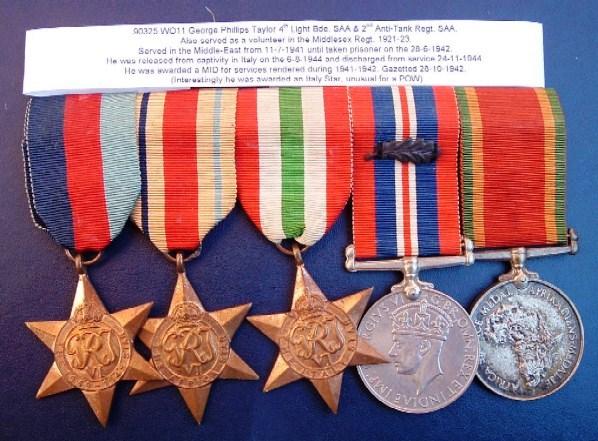 1
1 -
The medals all look the same and like you I believe 100% of the time that it's the story that counts! Wonderful job on research on these men.
John
It is all about the story behind the medals!
I will post a few other groups with different medals in the groups but for 99% of the SA guys who were taken in the North African theatre of operations a group of 4 were their sole entitlement.
Regards
Brian
1 -
4145 Pte Percy Talbott Deslandes Mallett
1st SAI Battalion C Coy (Kimberley Company)
Wounded and POW 18-7-1916 Battle of Delville Wood.
(Served with the 7th Infantry (Kimberley Regt) in GSWA)
Mallett had attested with the Kimberley Regiment or 7th Infantry Regiment as it was referred to during the German South West African campaign, serving until the Regiment was disbanded from the 24th August 1914 to the 28th May 1915, with the service number L5025. He then transferred to the South African Veteran Regiment with the service number 1011 serving with them from the 25th June 1915 until the 17th August 1915.
He was discharged from the SAVR for the “Purpose of joining overseas contingent”. Mallet was 20 when he re-attested to serve for his King and Empire, giving his father also Percy Mallett living in Kimberley as his next-of-kin. He was single, was a member of the Church of England with no trade so he had possibly been a scholar previous to his army service? Percy re-attested at Potchefstroom on the 2nd September 1915 and was allocated to C Coy 1st Regiment SAI due to his Kimberley links. Below is a section of my Booklet on the History of the SA Brigade detailing the actions and movements of the Brigade in chronological order, and relate to Mallets experiences with the South African Brigade until he was wounded and captured on the 18th July 1916.
28th August 1915-21st September 1915 The South African Brigade departs for England under the command of Brigadier-General Henry Timson Lukin, C.M.G., D.S.O., the Inspector-General of the Union Forces.
October to December 1915 the South Africans are quartered at Bordon in England.
The SA Brigade was at first attached to the 16th (Irish) Division but on the 7th December 1915 it was decided that the South Africans would first travel to Egypt to assist the British and Imperial forces on the Egyptian western frontier. They would form part of the Western Frontier Force under the overall command of the British General Peyton. This campaign was due to the threat posed by the pro German/ Turkish Arab Senussi Tribesmen, who were very active on the eastern Egyptian border with Libya. It was feared that an invasion of Egypt by the Senussi would take place thus threatening the Suez Canal.
30th December 1915 SA Brigade embarks at Devonport for service in Egypt.
10-13th January 1916 The South Africans arrive at Alexandria and set up themselves up at Mex Camp, six miles west of the city.
21-22nd January 1916 The 2ndRegiment move to Matruh by boat to prepare for their first baptism of fire. This sixteen-hour voyage plus an 18-mile march to Bir Shola found the regiment rather weary.
23rd January 1916 The 2nd Regiment along with Australian, New Zealand, Indian and British forces attack the Senussi camp at Halazin and rout them, 2nd Regiment suffered 11 killed and 106 wounded.
25th February 1916 the 3rd Regiment involved in skirmish near Agagia. 1 man killed and 1 man wounded.
26th February 1916 The 1st and 3rd Regiments with British troops and six armoured cars under Major the Duke of Westminster attack the Senussi at Agagia, resulting in the capture of the Senussi General, Gaafer Pasha. This engagement resulted in the capture of the Port of Barrani. Battle casualties were 14 killed and 103 wounded.
15th March 1916 General Lukin dispatched the Duke of Westminster with his armoured cars and total personnel of thirty-two to pursue the retreating Senussi. The Duke caught up with and attacked the enemy’s camp at Bir Asisa and totally routed them bringing the Senussi threat under control. Although the South Africans did not take part in this final action they were now free to start what they had volunteered for, and that was to take on the Germans in the trenches of Flanders.
16th March 1916 General Peyton holds a parade at Sollum where he thanked all his men for the victory.
28th March 1916 The Brigade began its return to Alexandria by sea.
At the end of March 1916 the SA Brigade received new drafts, including 8 officers and 400 other ranks.
13-19th April 1916 The transports Megantic, Oriana, Scotian and Tintoretto convey the Brigade to France arriving in Marseilles on the night of the 19th. The 4th Regiment are quarantined until the first week in May due to a contagious sickness on the Oriana, the rest of the Brigade soon left for the front.
SA Brigade prepares for its part in the Battle of the Somme.
23rd April 1916 Billeted at Steenwerck the SA Brigade were attached to the 9th (Scottish) Division, with whom they would serve for two years and share an amazing bond of suffering and glory.
1st July 1916 Start of the Battle of the Somme.
2-5th July 1916 SA Brigade in the Glatz sector of the front. The 3rd Regiment in action north west of Maricourt.
8-10th July 1916 A, C, and D Companies 2nd Regiment in heavy action at Bernafay Wood, incurred some 200 casualties.
10th July 1916 Two companies of the 4th Regiment relieved the 2nd Regiment troops in Bernafay Wood.
10-11th July 1916 4th Regiment in action at Trones Wood and Bernafay Wood. On the 11th July the 4th Regiment losses its Officer Commanding, Lieutenant-Colonel F A Jones at Bernafay Wood during some vicious fighting.
13th July 1916 SA Brigade concentrated at Talus Boise as the reserve brigade for the 9th Division. In its short while at the front the SA Brigade had sustained a total of 337 casualties.
14th July 1916 1st Regiment attack Longueval Village, desperate hand to hand fighting.
15-20th July 1916 Early on the 15th July the 1st Regiment retired from Longueval, and the 2nd, 3rd Regiment and 2 companies of the 4th Regiments enter Delville Wood. Later in the day a company of the 1st Regiment is dispatched to reinforce the 2nd Regiment due to heavy losses. On the 18th July the fourth day of the battle things were getting desperate and reinforcements from the 1st Regiment were sent in. Portions of the 1st and 4th Regiments were relieved by mid-night of the 12th July. Throughout the19th and 20th July, the remnants of the SA Brigade in Longueval and Delville kept on fighting until relieved at six o’clock on the 20th July. Only 3 officers and 140 totally exhausted other ranks marched out of action that day! The SA Brigade’s first VC was awarded to Private W F Faulds of the 1st Regiment on the 16th July. Casualties from the 14th to the 20th July amounted to 2320.
It is recorded on page 198 in the book Delville Wood by Ian Uys that the first roll call for C Coy on the morning of the 18th July 1916 was “answered by 30 of the 200 men of C Coy’s full strength”
Percy Mallett had endured 4 days of hell and on the 18th July after being wounded 3 times, shrapnel wound in the face, right shoulder and hand was finally captured by fresh German troops entering the battle. An account of a capture by Pte Victor Casson (also “C” Coy 1 SAI) is recorded in full on page 171 in the book Delville Wood by Ian Uys. Some of it is transcribed here:
“At about 11 am (18/6/1916) the Germans intensified the shelling of the wood, till it became a rain of death from the skies. It intensified to such an extent that the remaining trees and undergrowth were blasted and eliminated from a once beautiful wooded park” and some more “About 5 pm the beautiful rain of hell fire, ceased as if never occurred. It became dead silent except for the dying and wounded calling for water and help, and the occasional small arms fire. I realised that I was the only live man standing on my feet among the fallen tree trunks and numerous shell craters” He recorded that the Germans had advanced into this weakened section and before he could retire was confronted by Germans fortunately led by an Officer that restrained his troops from shooting him. Mallett must have been taken prisoner around the same time and sent to Ordruf Hospital in Germany. A picture showing South African wounded prisoners at the hospital, which includes Mallett (he is second from the top right) is on page 221 of the book Delville Wood by Ian Uys.
After he recovered he was posted to the POW camp at Langensalza the County of Unstrut-Hainich, Thuringia, Germany, (described by one soldier as the most sinister POW camp in Germany) from which many of the prisoners were often sent to the salt mines nearby. It appears he was transferred later to the POW camp at Cassell, in Northern Hesse, the archive records are unfortunately a little feint to make out the finer details. (See footnote)
He was repatriated to England on the 3rd January 1919. He spent a number of months in England before finally embarking on the Cawdor Castle passenger liner for passage to South Africa; he arrived in Cape Town on the 24th April 1919. He was finally discharged at Maitland in Cape Town on the 24th May 1919 after spending 3 years and 280 days in the Service. His address on discharge was given as Box 21 George Cape.
His 1914-15 Star was despatched to him on the 6th November 1920 and his British War and Victory Medals were despatched to him on the 1st February 1923.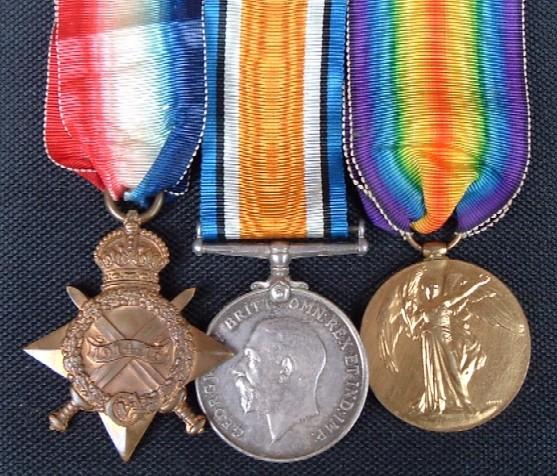 1
1 -
115574 Cpl Joseph Herran
Technical Service Corps (Att. to 6th Armd Car Regt)
POW 14th June 1942
Herran had been born in England on the 9th December 1908 and was a motor mechanic by trade. He was married to Alice Mary and lived at Randfontein on the West Rand in Johannesburg. They had 3 children 2 girls and a boy. He attested with the Central Artisan Training Depot Voortrekkerhoogte on the 1st April 1940, at the age of 31.
Herran was placed on strength with the No 1 Light Tank Coy. He spent some time at the Military College. However on the 3rd July 1940 he went AWOL for a number of days. After returning he was transferred to the 4th Armoured Car Coy on the 28th July1940. On the 26th September 1940 he went AWOL again this time he was declared a deserter! He returned to the service on the 7th November 1940 after an absence of 63 days he received 21 days in DB for his efforts.
He was transferred as a private to the Armoured Fighting Vehicle Training Centre Kafferskraal on the 12th December 1940.
On the 21st March 1941 he embarked at Sonderwater with the 13 Armoured Car Coy (attached Tech. Services) and they drove in convoy through to Broken Hill on the 25th March and arrived in Nairobi on the 8th May 1941. They departed Gil Gil on the 3rd June 1941 to Kilindini where they embarked per SS Yoma on the 5th June with the 6th SA Armoured Car Regt. They disembarked at Suez on the 17th June 1941. He was promoted to T/CPL on the 1st October 1941; this was later made substantive on the 1st October 1943.
After serving through the battles of Mersa Matruh, Sollum, Halfaya and Bardia the South Africans fell back to the Gazala Line and dug in preparation for the upcoming attack by the Germans in their attempt to take Tobruk. The 6th SAACR were based in the northern “Bastion” of the defensive line with the British 50th Division. The Battle of Gazala commenced on the 26th May 1942. After very heavy action Bir Hakeim fell and despite attempts to hold the allied forces were forced to withdraw towards Tobruk. Things started to get desperate and on the 14th June the British 50th Div moving in two main groups broke out of its Gazala positions westward and then southward by smashing gaps in the Italian Lines, using infantry and supporting arms. They held the escape routes open while the rest of their respective groups passed through. The 6th SAACR split its troops between the two columns. During this fighting breakout the “B” Squadron lost six thin skinned vehicles (support tech services), 4 troops were recorded missing and 1 wounded. “A” Squadron lost 9 armoured cars, 10 three tonners and eight cwt. Trucks and a wireless vehicle, one officer and one other rank killed and 22 missing. The sections that escaped eventually got clear they assembled west of Tobruk before heading for the frontier with Egypt and thus escaped being taken POW at Tobruk.
Joseph Herran was one of the unlucky few who did not escape and was taken prisoner on the 14th June 1942. He was taken to Tripoli then interned at Palermo Campo 52 and onto Genoa in Italy. With the fall of Italy he was sent to Stalag VIIA at Moosberg in Germany then onto Stalag 344 at Lamsdorf in Silesia with the POW number 30627. With the defeat of the German armies on the Eastern Front the Russians began advancing towards Germany. The POWs at Lamsdorf and other camps in the east were marched back into Germany during the extreme winter of 1944 and 1945, in what has become known as the “Death Marches”. Herran and a number of his fellow Lamsdorf POW’s were marched back to Bad Orb and interned at Stalag IX B, which just happened to have the reputation of one of the worst German prisoner of war camps. It housed many Americans taken during the Battle of the Bulge. He was released on the 8th April 1945 suffering from severe malnutrition and acute gastro-enteritis. He was treated at the 179th General Hospital (US), initially he was fed 6 feedings daily on a “soft diet” and by the 18th April he was on a full diet and “looking much better”. By the 24th April 1945 he was fit enough to fly to the UK.He returned to the Union on the 9th June 1945 and after spending a few months with the Rand Light Infantry and Armoured Car HQ in JHB he was finally discharged fit on the 4th February 1946.
His full medal entitlement was a 1939-45 Star, Africa Star, War Service Medal with MID and Africa Service Medal which were dispatched to him on the 2 March 1953. His citation for his MID is a mystery but there is a mention of “(Corresp 15.3.43)” regards the MID with a reference of (FO 4/43/356)?
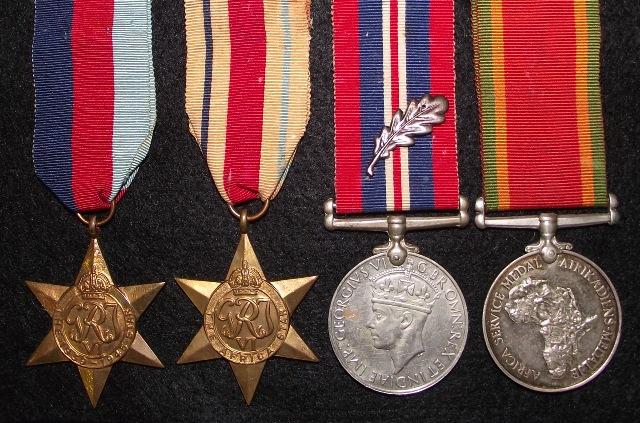
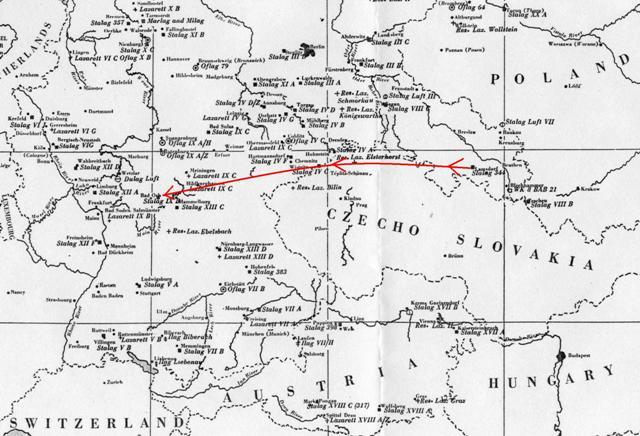 1
1 -
1938 Gnr. Victor Ray Holmes
RDLI and 2nd Field Regiment SAA (NFA)
(POW Tobruk 20/6/1942, escaped to Switzerland 15/2/1944.)
Holmes, single and a Salesman by trade had been born at Mount Frere in the Cape Province on the 3rd September 1922. At the young age of 17 years and 8 months he attested with the 2nd RDLI on the 18th May 1940 at Pietermaritzburg, Natal. His Next-of-Kin was given as his father, Stanley Holmes address PO Box East Griqualand, although he gave his home address as 30 Kenilworth Rd Durban.
He assumed full time service on the 20th June1940. He was promoted to L/Cpl on the 1st August 1940. He went on manoeuvres with the unit in the Eastern Transvaal where he went AWOL at Barberton on the 18th January 1941 and was punished by being reverted to the ranks on the 30th January 1941. Photographs that came with the group show that he appeared to have been mustered as a dispatch rider with the Regiment.
On the 9th June1941 he embarked at Durban for the Middle Eeast per SS “Ile de France” disembarking 11 days later at Suez on the 20th June1941. On the 17th April 1942 for unexplained reasons he was posted to 2nd Fd Regt SAA (NFA). Barely 2 months after joining the NFA and 1 year to the day of his arrival in the Middle East, he was taken POW when Tobruk capitulated to the Axis forces on the 20th June 1942.
According to his “POW REPORT” held at Kew, the following info about his period of captivity and subsequent escape to Switzerland is recorded:
“After the capitulation we received orders to destroy our guns, and were picked up soon after by German Tanks.”
Unfortunately no record was made for his internment in North Africa but many of the Tobruk captives were held at Benghazi before being shipped to Italy. He was held in P.G. 60 at Lucca from the 24th July 1942 to the 17th November 1942 being transferred to P.G. 65 at Gravina from the 17th November 1942 until the 6th April 1943. He was then sent to a Working camp P.G. 62/47 at Calvisano, Bergamo and it is recorded that he carried out farming duties. With the Italian armistice many of the “ex-prisoners” were released and Holmes was one of them. In this statement he records his escape to freedom:
“First of all (after the armistice) all six of us went to the farm where we had been working. In a round up made by Germans and Fascists four of us were caught, I and another fellow dived out of the window (train) and into a culvert and were not caught, stayed in the same neighbourhood until 13 Feb 1944, when I decided to go to Switzerland and was in the train between Brescia and Edolo when it was inspected by Italians for identification cards. I was caught and put in a civilian gaol, from which the Germans took me and put me in a railway cattle truck with 14 other British troops, we managed to make a hole in the back of the truck which was at the back of the train, and were out of it after about half an hour. I then started to walk towards Switzerland. About fifteen kilometres from the frontier I met an Italian guide carrying an old Jewess in a basket on his back, as he was going to Switzerland I decided to go with him. We crossed the frontier at Campo Cologna.”
This was on the 15th February 1944 just 2 days after escaping from the train.
Also recorded in the report are the names of the 3 families who “helped him continually in every way for five months” Angelo Trentini, Angelo (?) Favagrossa and Paulo Bossini all from Calvisano, Brescia.
In his military records it was only recorded that he was a POW at Camp 65 in Italy on the 18th November 1942. He was classed as “Released POW (Italy) 26th September 1944” He arrived in Egypt on the 11th October 1944. After being granted a few days leave in Egypt, he emplaned for the Union on the 8th November 1944.
On his arrival back in the Union he was sent on course at the SA Military College in Pretoria from November 1944 to March 1945, it then appears he was attached to the GSC for a short period before being discharged in Durban on the 4th May1945. He returned to his civilian occupation as a Salesman with Cymot Ltd, Durban.
This group came with a lot of original paperwork and photographs including scarce escaped POW paperwork and photographs from his stay in Switzerland.
His full medal entitlement is a 39/45 Star, Africa Star, The War Medal and Africa Service Medal, which were dispatched to him on the 11/9/1954 but they were returned. They were later re-despatched to him on the 11/4/1957.
Pic 2 shows his Union Defence Force escape card and a photo of the Clark family with whom he stayed with whilst in Switzerland, I hope somebody might assist with further info on this family. I suspect they might have been with the British diplomatic corps in Switzerland?Pic 3 Shows his British ID Document issued to him on his arrival in Switzerland, this is a rather rare item, I have only seen one other!
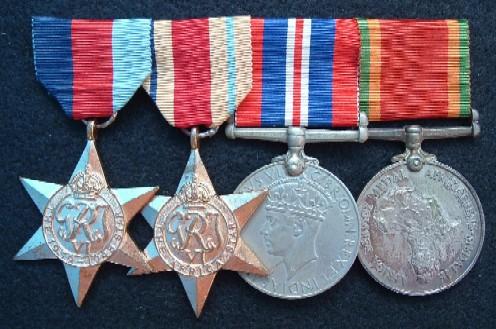
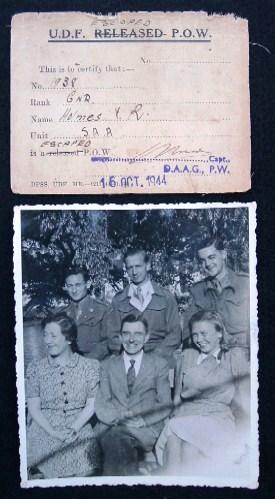
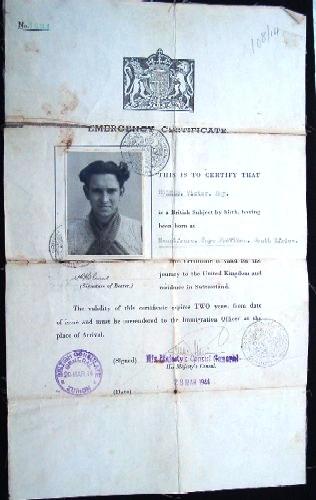 1
1 -
10899 Pte. David Donald Strachan
2nd Regt. 1st SA Infantry Brigade, France(WW1 POW Germany)
Born in Arbroath Scotland, at 19 he enlisted for service with the 6th SAI for service in GEA on the 3rd December 1915. As with hundreds of other South African troops, he was repatriated suffering from malaria and the effects of dysentery. He was finally discharged Medically Unfit after 1 year and 73 days service on the 14th December 1916.
Only a few days later on the 8th January 1917 he re-attested for service with the 2nd Regiment 1st SA Infantry Brigade to serve in France. After spending 2 months in England he was posted to France on the 20th May 1917 but contracted a minor dose of Measles, and was hospitalised at Rouen. He proceeded to the front on the 13th July 1917 joining his Regiment on the 15th July 1917.
He took part in the Battle of Menin Road when L/Cpl W H Hewitt of the same unit won his Victoria Cross. This was one of only two Victoria Cross awards to the 1st SA Infantry Brigade during the War. He went on to serve through the Attack on Chapel Hill on the 21st March 1918 and finally the now famous stand at Marrieres Wood on the 24th March 1918 where he was one of the final 100 survivors who had fought to the last bullet, until finally surrendering to the overwhelming German forces. It was rumoured that after the battle, the South African officer in charge of this group of brave South Africans was severely reprimanded by the Crown Prince of Germany for not surrendering earlier, as it had been a fruitless defence, but respected their bravery!He was released from captivity in Germany on the 13th December 1918, and repatriated to South Africa where he was finally discharged on the 24th May 1919.
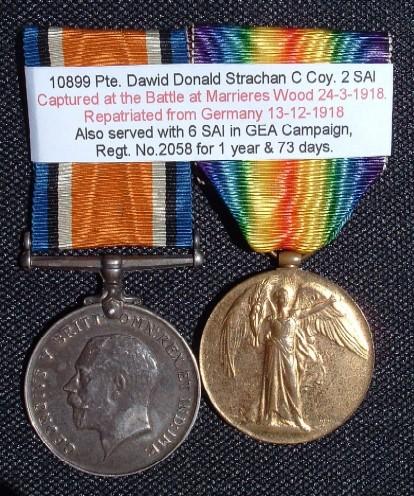 1
1 -
2141 Pte Sydney Ernest Avis
“A” Coy Royal Durban Light Infantry
POW Tobruk 20-6-1942
Avis was born on the 25th June 1917 in East London, South Africa. He was single and gave his civilian occupation as a Papermaker and claimed previous service with the RDLI since 1936. At the age of 23 Avis attested with the Union forces on the 23rd May 1940, and assumed full time service with “A” Coy RDLI at the Premier Mine, on the 20th June 1940. He was a Wesleyan and gave his father Mr Joseph Avis who lived at 15 Wellington Rd, Point Durban as his next-of-kin.
After a year of training he embarked at Durban for the Middle East per S.S. Ile de France on the 9th June 1941 and disembarked at Suez on the 20th June 1941. On the 26th August 1941 he was sentenced to 6 days CB for Contra Sec 40 MDC (conduct to prejudice of good order and discipline) by the officer commanding “A” Coy RDLI Capt C W Arnold.
On the 20th June 1942 exactly a year to the day after arriving in the Middle East and 2 years to the day of being posted to the RDLI, he was captured at Tobruk by the Axis forces along with thousands of other allied troops.
Avis was interned at Campo 53 at Sforza Costa (near Macerata) in Italy, a large camp that could house up to 10 000 prisoners before being transferred to Stalag 8C at Kunau Kr Sprottau/Sagan in Poland/Germany with the POW number of 80177.
Stalag VIII-C was a World War 2 German Camp adjacent to the famous Stalag Luft 3 (of Great Escape fame) near Sagan, Germany, (now Zaga, Poland). It was built at the beginning of World War II and occupied 48 ha (120 acres).
The camp initially housed several thousand Polish prisoners from the early German September 1939 offensive. In a ruthless breach of the 3rd Geneva Convention most of these prisoners were deprived of their POW status in June 1940 and transferred to labor camps. French and Belgium soldiers taken prisoner during the Battle of France took their place, many of them from Algeria, Morocco and Senegal. In 1941 more prisoners arrived from the Balkans Campaign mostly British, Canadian, Greek and Yugoslav. These were followed by Soviet prisoners from Operation Barbarossa. In late 1941 nearly 50,000 prisoners were crowded into space designed for one third that number. Conditions were appalling, starvation, epidemics and ill-treatment took a heavy toll of lives. By early 1942 the Soviet prisoners had been transferred to other camps, particularly to Stalag 8 E at Neuhammer. New prisoners arrived from the Western Desert Campaign in North Africa, especially after the fall of Tobruk in June 1942. These were principally Australians, South Africans (both white and black) and Poles.
In early February 1945, many of the prisoners, particularly British and Commonwealth, were marched westward ahead of the Soviet offensive. The German camp command destroyed documentation and evidence of the crimes committed. On the 14th February 1945 the Red Army entered the camp. They later used the camp to house German prisoners. In 1961 a monument was erected at the cemetery in remembrance of the thousands who died and are buried here. In 1971 the "Martyrdom Museum of Allied prisoners of War" was established on the site of the camp to house mementos and records of both Stalag 8 C and Stalag Luft 3.
After years of imprisonment and lack of a decent diet, extreme hardships had to be endured during the icy conditions by the prisoners on these forced "death" marches, including being shot at and bombed by trigger happy allied air force pilots. Tragically many died along the way, only days away from freedom.
Sidney Avis was finally released and repatriated to England arriving in the UK on the 14th April 1945. After spending four months recuperating in England he was finally repatriated to South Africa, arriving in Cape Town on the 11th September 1945.
However Avis had to wait a few months before he was discharged as it appears he got involved in a fight on the 19th October 1945, receiving a “kick in the scrotum”. He spent 11 days in the Springfield Military Hospital in Durban due to his injury. He was discharged from hospital on the 31st October 1945. After his hospitalization he spent time at various camps around Durban until he was finally discharged on the 9th January 1946.
His full medal entitlement was a 39-45 Star, Africa Star, British War Medal and an Africa Service Medal which were dispatched to him on the 13th January 1953.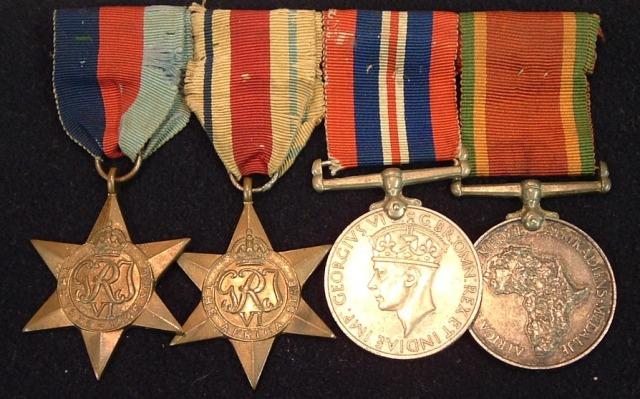
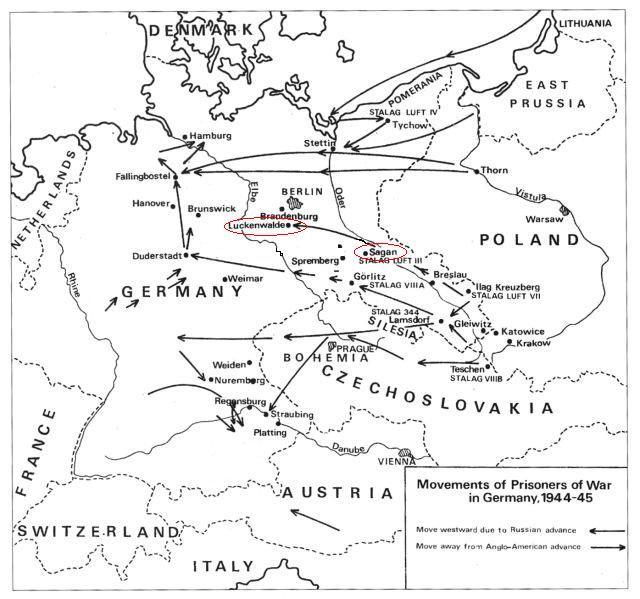
 1
1 -
5544 Sgt Kenneth Thomas Wilkinson MID
Umvoti Mounted Rifles
POW Tobruk
Received MID for escaping
Kenneth Wilkinson had been born in Durban on the 13th April 1921 and worked as a Salesman. He attested for full time service on the 26th September 1940. He had served with the Cape Garrison Artillery in an A.C.F. capacity from the 22nd February 1939 until the 11th May 1940 with the service number 77992. His father F. L. Wilkinson was his nominated next-of-kin living at 272 Bree Street, Johannesburg. He came from a family who had a long line of military service, his father F L Wilkinson had been a member of the Natal Police in the 1906 Bambata Rebellion and his grandfather had been a member of the Natal Royal Rifles in the 1880’s.
After attesting he was posted to the Umvoti Mounted Rifles as a private. On the 21st July 1941 he embarked per SS Elizabethville for the Middle East. He disembarked at Suez on the 14th August 1941. He spent a number of days in and out of hospital from the 26th October 1941 until 11th March 1942; the last stay in hospital was due to a sprained ankle whilst skating off duty.
He was taken POW on the 20th June 1942 at Tobruk along with thousands of other allied troops. Nothing is known about the various POW camps he was interned in whilst held in Africa and his early stay in Italy. However on record at the National Archives at Kew in London is his citation for his MID, it appears he teamed up with a fellow South African Gunner Theodore Nel of the Transvaal Horse Artillery and after the capitulation of the Italians on the 8th September 1943 they construed to get back to allied lines at all costs, and here is their story care of the citation and it makes interesting reading:
NEL and WILKINSON were captured at TOBRUK on 21st June 1942, and were released from Camp 120/IX (Chiesanuova, San Marino) in September 43. Recaptured on 13 Nov 43, they succeeded in crawling under the fence and escaping six days later.
They attempted to reach allied hands, but owing to the snow did not proceed beyond AQUILA. They spent four months at SEVELLE before they were recaptured on 26 Apr 44.
Seven weeks later NEL and WILKINSON escaped from PERUGIA wearing German uniforms and accompanied by three German deserters. After reaching SPOLETO in a German convoy, they took refuge in the mountains until Allied forces arrived.
They rejoined the allied lines on the 19th June 1944. He was placed “On strength released POW list” on the 24th June 1944.
He emplaned for the Union on the 29th July 1944. On his return to the Union Wilkinson was granted leave from the 1st August 1944 until the 22nd October 1944. He reported to the Military College on the 23rd October 1944 until the 30th November 1944 attending course 1415 P. He was then taken on strength with the GSC/NEAS. On the 2nd December 1944 he was promoted to T/Sgt and on the 22nd December 1944 to A/S/Sgt.
He was finally discharged at Durban on the 27th February 1946.His full medal entitlement was a 1939-45 Star, Africa Star, War Medal with MID emblem and Africa Service Medal.
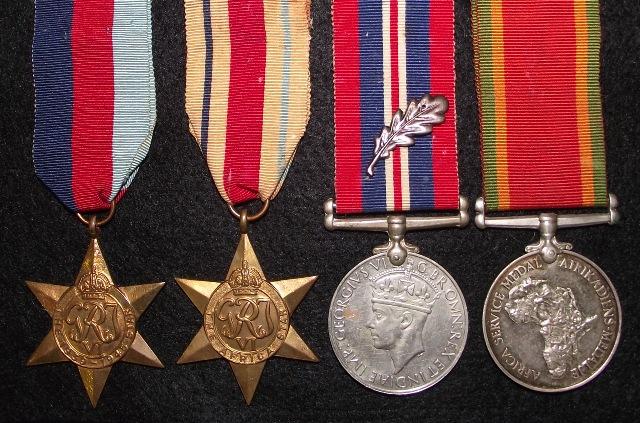 1
1 -

89826 L/Bdr David Gower Evans Hanes
2nd Field Brigade SAA (NFA)
Hanes was born on the 12th December 1912 in Krugersdorp in the Transvaal but for some reason claimed to be “Welsh”. He worked on the SA Railways as a Steam Hammer Driver, based in Pietermaritzburg Natal. He was married and had one child.
He had served as a territorial soldier serving with the Natal Field Artillery, with the unit number 12324 from 1st July 1933 to 30th June 1937, when he was placed on the Class A Reserve. With the outbreak of the Second World War he attested to serve with the NFA on the 24th June 1940.
He proceeded north disembarking at Suez on the 12th August 1941. He was taken prisoner on the 20th June 1942 at Tobruk. He was held captive in North Africa at Benghazi until the 7th November 1942; he was then shipped to Italy and placed in captivity at Bari from the 15th November 1942 to the 26th November 1942. He was then transferred to Campo 65 being interned there from the 27th November 1942 until the the 7th March 1943. He was then transferred to Bergamo Campo 62 from the 8th March to the 16th March 1943 before being sent to a “Work Camp” at Agnadello, Campo 62/17 on the 17th March 1943. Here he was assigned to do “farm work”. With the Italian Armistice on the 8th September 1943 he was released by his guards, his escape story as recorded on his P.O.W. Report held at Kew is as follows:
“On Armistice we were released by our guards. We returned to our working farm and carried on as civilians for about a week. We then went down to Spino (The Addo), a little farm on the banks of the River Addo. There I met up with another Britisher and we decided to go south. We got assistance from friendly Italians and crossed the River Po, by boat. From there we journeyed down as far as the outskirts of Pisa. At various stops we were given food and shelter by friendly Italians. Owing to the heavy fall of snow, we found we could not get further south, so we decided to go to Switzerland. This was about 30/9/43”
He gave the following persons as giving assistance to him (and his British mate):
1) Teresa Villa from Cremona for supplying food, money, clothes, and sleeping quarters.
2) Luicia Bosi from Milano for supplying food and clothing.
3) Lani Elisor from Brescia for supplying clothes, and support by train. (Was this the Italian officer, see escape info in next paragraph.)
He continued to describe his Escape information later on in Section 6 of the report, as follows:
“We managed to get as far back as Cremona on our own. There we contacted a friendly Italian Officer. He straightaway purchased tickets for us, and travelled with him as far as Brescia by train. From there we carried on by train with him to Edolo. From this point we carried on our own, by foot, and entered Switzerland via Tirano into Campo Cologna on 19/11/43.”
With the collapse of German rule in Italy he was repatriated to Italy on the 26 September 1944 and arrived in Egypt on the 11 October 1944. Three weeks later he was flown back to South Africa and granted 9 days leave. He was admitted to hospital on the 6th February 1945 and discharged on the 1st March 1945 suffering from Anxiety Neurosis possibly brought on by his spell as a POW. He was discharged as medically unfit by the medical board on the 22nd March 1945. On discharge he was issued with an Invalidity Badge No: 37898.
His full medal compliment was a 39-45 Star, Africa Star, War Medal, Africa Service Medal and an Efficiency Medal. The last medal was approved on the 23 July 1945 and awarded to him on the 16th February 1946.1 -
Sorry guys but I am unable to paste my info into these posts, the "paste " option is greyed out??
0 -
What started out as a "sub theme" in my medal collecting, has turned out to be one of my main collecting areas.
I find these groups interesting to say the least, as it can be said that they were "definately there"!
Hardships being the order of the day, many losing their lives trying to escape and others dying due to sickness and being employed by the Axis to carry out forced labour in salt mines etc.
Towards the end of the War many of these weakened soldiers were forced to partake in forced marches, known as "Death Marches" to escape the advancing Russians. Winter conditions, lack of food and even trigger happy Allied fighter pilots took there toll and many never made it.
I will attempt to post at least one or two groups a week, sadly due to lack of time for my hobby of late I cannot to post daily.
Hope you all will enjoy the posts?
Regards
Brian
1 -
Guys
These pictures do not do Williams collection justice, one has to see them to really appreciate the collection as a whole!
Fortunately I've been privileged to have seen them and all the other items in this amazing collection on two occasions

Well done William
Brian.
0 -
What a wonderful display!!! What is the medal/badge with the red ribbon in the middle and to the left of the insignia? Were you able to find photos of him as a student at your school? I love the touching statement by his granddaughter.
On another subject, is it possible to say that all 1914 Stars to S. Africans would have been for GSWA? Thanks. John
John
As Brett said, a few 14-15 Stars were awarded for GEA, but not many. I have one group to a trooper in the 2 SA Horse. They left Durban mid December 1915 and arrived in GEA just in time to qualify for the Star, basically it was one shipment of SA Troops from what I can work out?
Brian
1 -
Hi Merwyn
Sad to say but this tag should of stayed with the medals, adds a great deal of value to the group but on their own not that valuable. With so many of our chaps being taken prisoner there must be a large number around, however that being the case, I suspect once freed a large number of our chaps would have used these as frisbies. There were different types, later in the war when the Germans were running short on metal, they even produced wooden ones.
I will soon start a thread here on POW groups in my collection. I will endeavour to add bits and pieces as well.
Regards
Brian
0 -
Hi Azyeoman
My friend Brett Hendey told me about this thread, glad he did

As a fellow POW collector and have a number ranging from WW1 to WW2, 99% South African I must say your collection is impressive. What started as a "sub-theme" for me has actually become a major one. There is always something to find on these guys, especially if they escaped. I have not been a huge contributer here on the GMIC but will start to add some of mine. Hope you will find them interesting when I start.
One of my highlights was finding a diary convering a South African Policeman Officers time as a German guest. A large number of SA Police fought as infantrymen and many were taken at Tobruk when it fell.
Not much free time so please be patient.
Regards
Brian
1 -
Mervyn
The gun mounted on the memorial is a six inch howitzer. This artillery piece was the most common weapon used by the SAHA in Europe.
The SAHA did not partake in the Palestine theatre, the SA Field Artillery took part in this campaign.
The Heavy Artillery Brigade that took part in the GSWA Campaign and the SAHA who fought on the Western Front were two different units. I will post some info to clear up the confusion that many collectors and people in general have regards these 2 units:
Heavy Artillery Brigade: (World War 1 GSWA). Government Notice 434, 27/2/1913 authorized the formation of the South African Garrison Artillery to be established on the 1st July 1913. It consisted of members of the 1st Division being the Cape Garrison Artillery and the 2nd Division being the Durban Garrison Artillery under the command of Lt-Col. J M Rose. The batteries sent to German South West Africa from this brigade comprised C, D, F, N and K Batteries.
They were equipped with 4.7 and 4-inch naval guns. Once its services were no longer required, the brigade was disbanded in June 1915. Recruiting began in July 1915 for the new Heavy Artillery Regiment that was being formed for service in France, many ex-members of the Heavy Artillery Brigade re-attested to continue serving their country, only this time a lot further from home and in totally different conditions.
This earlier Heavy Artillery Brigade must not be confused with the South African Heavy Artillery, formed for service in France, although it was the forerunner of the later.
Shoulder title was a brass HA. I believe this badge is not in Owen's.
South African Heavy Artillery (SAHA). After the end of hostilities in German South West Africa ex-members of the Heavy Artillery Brigade and other volunteers who did not wish to serve in German East Africa, Egypt and Palestine theatres, reformed into five batteries between July and August 1915 for service in France. Criteria were rather strict for the initial group and only members of fine physique and a standard height of 5 feet 8 inches were accepted. The roll was closed when it reached a total of 600 men.
Once the five batteries of volunteers arrived in England from South Africa they were each armed with four 6-inch 26cwt Breech Loading howitzers and became affiliated to the Royal Garrison Artillery. They respectively became the 71st, 72nd, 73rd, 74th, and 75th Siege Batteries, RGA. Later in April 1916 a sixth battery, the 125th was formed. Early 1918 saw a seventh the 542nd and eighth the 496th created but on arrival in France, they were split up and men and guns dispersed, the 542nd between the 75th and 125th and the 496th between the 72nd and 74th batteries. A ninth battery, the 552nd, armed with 8-inch guns, was formed later in 1918 but the War ended before it could be brought into action.
For most of the War the six batteries acted as independent units, being allotted to widely separated corps and other heavy artillery groups. Only on three occasions did they support the 1st SA Infantry Brigade and then only at battery strength! The three occasions are as follows: the 75th Battery at Butte de Warlencourt, the 71st Battery at Third Ypres and the 74th Battery at
Arras. At the beginning of 1918 they were brought together, and two South African Heavy Artillery Brigades were formed these being the 44th Brigade and the 50th Brigade.
They took heavy casualties and won numerous awards for their distinguished service and courage in the terrible conditions found on the Western Front. The famous author Sir Percy Fitzpatrick’s only son Lieutenant and later Major Percy Nugent George Fitzpatrick, formally of the Imperial Light Horse and later the Heavy Artillery in German South West Africa, was one of the original group of officers to volunteer for service in the SAHA in France. Unfortunately he was killed by shellfire near the end of hostilities in 1918.
Below is a short history of each Battery as well as their Battle Honours. They have been placed in original battery order and not Royal Garrison Artillery order.
73rd (Cape) Siege Battery SAHA RGA. This was the 1st Battery of the original five batteries sent out from South Africa to become the South African Heavy Artillery affiliated to the RGA in World War 1. Commanding officer was Major Brydon.
It was this Battery that achieved the all time First World War record rate of fire, firing 32 rounds in 8 minutes with each gun.
Battle honours for this Battery were as follows, granted by GO 5997 of 21st April 1926:
Somme 1916, Pozieres, Thiepval, Ancre 1916, Arras 1917, Ypres 1917, Menin Road, Lys, Bethune and Pursuit to Mons.
74th (Eastern Province) Siege Battery SAHA RGA. This was the 2nd Battery of the original five batteries sent out from South Africa to become the South African Heavy Artillery affiliated to the RGA in World War 1. Commanding officer was Major Pickburn.
This battery once recorded firing 1733 rounds on the 1st July 1916. This battery also had the honour of being the last South African battery to take part in action during World War 1, when on the 20th October 1918 when it supported a Canadian attack in the area around Wallers.
Battle honours for this Battery were as follows, granted by GO 5997 of 21st April 1926:
Somme 1916-18, Pozieres, Ancre 1916, Arras 1917-18, Oppy, Messines 1917, Ypres 1917, Menin Road, Passchendaele and Pursuit to Mons.
71st (Transvaal) Siege Battery SAHA RGA. This was the 3rd Battery of the original five batteries sent out from South Africa to become the South African Heavy Artillery affiliated to the RGA in World War 1. Commanding officer was Major Harrison.
Battle honours for this Battery were as follows, granted by GO 5997 of 21st April 1926:
Somme 1916, Pozieres, Flers-Courcelette, Thiepval, Bullecourt, Ypres 1917, Passchendaele, Cambrai 1917, Lys and Pursuit to Mons.
72nd (Griqualand West) Siege Battery SAHA RGA. This was the 4th Battery of the original five batteries sent out from South Africa to become the South African Heavy Artillery affiliated to the RGA in World War 1. Commanding officer was Major Alston.
Battle honours for this Battery were as follows, granted by GO 5997 of 21st April 1926:
Somme 1916-18, Pozieres, Thipval, Ancre 1916, Arras 1917-18, Ypres 1917, Passchendaele, Scarpe 1918, Droucourt-Queant and Pursuit to Mons.
75th (Natal) Siege Battery SAHA RGA. This was the 5th Battery of the original five batteries sent out from South Africa to become the South African Heavy Artillery affiliated to the RGA in World War 1. Commanding officer was Major Tripp.
This battery recorded firing 1312 rounds before noon on the 1st July 1916, a remarkable achievement.
Battle honours for this Battery were as follows, granted by GO 5997 of 21st April 1926:
Somme 1916-18, Bazentein, Pozieres, Flers-Courcelette, Ypres 1917, Poelca-Pelle, Scarpe 1918, Droucourt-Queant and Pursuit to Mons.
125th (Transvaal) Siege Battery SAHA RGA. Formed in 1916 as the 6th South African Heavy Artillery Siege Battery. Commanding officer was Major Begbie.
Battle honours for this Battery were as follows, granted by GO 5997 of 21st April 1916:
Somme 1916, Flers-Courcelette, Thiepval, Ancre 1916, Arras 1917, Scarpe 1917, Ypres 1917, Cambrai 1917, Lys, Bethune and Pursuit to Mons.
496th Siege Battery SAHA RGA. Formed in 1917/18 but its men and guns were later dispersed as replacements amongst the 72nd and 74th Batteries of the SAHA.
542nd Siege Battery SAHA RGA. Formed in 1918 but its men and guns were later dispersed as replacements amongst the 75th and 125th Batteries of the SAHA.
552nd Siege Battery SAHA RGA. This was the 9th and last Siege Battery of the SAHA and was formed late in 1918 to be armed with 8-inch guns but the War was over before they could be brought into action. It’s commanding officer was Major Ridley MC and Bar.
The 2 composite SAHA Brigades were as follows:
44th South African Heavy Artillery Brigade. Formed in 1918, this Brigade consisted of the South African 71st, 73rd, 125th and British 20th Siege Batteries RGA. Commanding officer was Lt Col Blew DSO.
50th South African Heavy Artillery Brigade. Formed in 1918, this Brigade consisted of the South African 72nd, 74th, 75th, and British 275th Siege Batteries RGA. Commanding officer was Major Tripp.
Owens 892 to 900, 1268, 1732, 2232 to 2234 and 2310 to2312.
A few years back I managed to acquire Major Percy Nugent George Fitzpatrick's British War Medal from a collector in the USA. Sadly his trio had been broken up some time in the past, however, I am still privilaged to have this historical medal in my collection.
It must be remembered that Sir Percy was the one who orchestrated the idea of a two minute period of silence, largely brought about by the death of his son.
I hope this info will help ?
RegardsBrian
0 -
There were approximately 150 SAHA losses in WW1.
0 -
Gunner Deas noted on memorial.
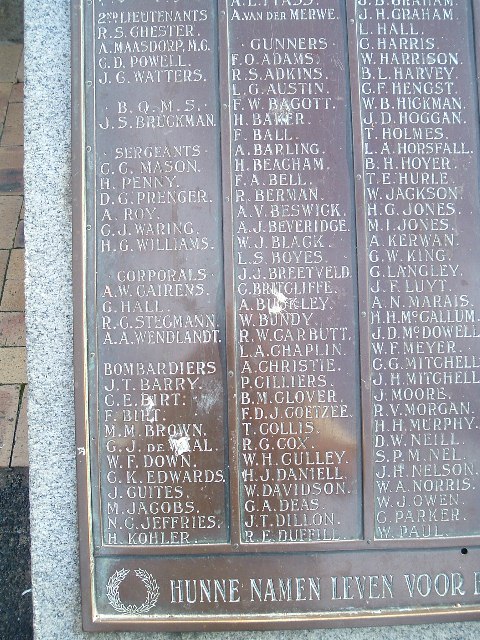 0
0 -
Meanwhile - please note that he was with South African Heavy Artillery. Normally they are quite a way behind
lines - so it will be interesting to find out the circumstances. I am hoping that Arthur will spot this post and,
perhaps be able to help with the total number of casualties to Heavy Artillery - I, somehow, don't think it will
be a very big number.
http://gmic.co.uk/uploads/monthly_08_2012/post-6209-0-89465100-1345041863.jpgclick
Merwyn
A great misconception about artillery groups is that they were not in the frontline. However, these brave lads had to withstand what is known as counter battery fire, that is when the enemy guns range in on the oppositions guns in an attempt to put them out of action, terrible consequences resulted as these poor gunners were largely exposed and hence took a terrible toll as they did not have deep trenches to protect them. Then there were attacks from the air, pilots like nothing better than a few exposed artillery pieces to bomb or straff with their machine guns, basically they were sitting targets!
Artillery medals have a terrible stigma attached to them and are classed as Corps medals and hence cheaper than many of the Infantry units, many of these Infantry units came within earshot of the frontlines.
Attaching a picture of the SAHA Monument situated in the Cape Town gardens, plaque in front has all the deaceased gunners names, there are quite a few.
Regards
Brian
 0
0 -
Very nice, Mervyn and, as you say, unusual to find one of these not attached to a WW2 group.
A point not made in the Medal Yearbook is that whereas in the UK and elsewhere the Efficiency Medal was an army award, in South Africa it was a tri-service award. Hence, as in Cpl Hammond's case, it could be awarded to Active Citizen Force members of the air force.
Arthur
Rarest of all are issues to the navy, fortunately have one in a group. Figures of only 55 to 60 to the navy according to the Late Gordon Bickley.
Brian
0 -
Hi Brian
Are you going to publish the booklet on general release when its finished?
Cheers
Perce
Perce
Looking into a few options, it all depends on the number of pages and photo's at the moment. Busy with another project so unfortunately this one is a little delayed. Looking for some original info to add, so far managed to find 2 unpublished pictures, a personal diary and the OC's message book, besides the info from the archives.
Will keep you posted.
Brian
Brian
0


British Spitfire hunter
in Great Britain: Militaria: Badges, Uniforms & Equipment
Posted
When I first read up on this I got excited, sadly it now seems it was just a wild goose chase!
Brian